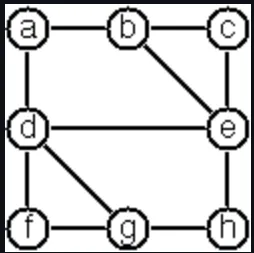August 27, 2024
P83 - Spanning trees.
Write a method spanningTrees to construct all spanning trees of a given graph.
When you have a correct solution for the spanningTrees method, use it to define two other useful methods: Graph.isTree and Graph.isConnected.
> "[a-b, b-c, a-c]".toGraph().spanningTrees()
[[a-b, b-c], [a-b, c-a], [b-c, c-a]]
> "[a-b, b-c, a-c]".toGraph().isTree()
false
> "[a-b, b-c, a-c]".toGraph().isConnected()
trueFind out how many spanning trees there are for the graph depicted below.
"[a-b, a-d, b-c, b-e, c-e, d-e, d-f, d-g, e-h, f-g, g-h]".toGraph()kotlin
package org.kotlin99.graphs
import com.natpryce.hamkrest.assertion.assertThat
import com.natpryce.hamkrest.equalTo
import org.junit.Assert.assertTrue
import org.junit.Test
import org.kotlin99.common.containsAll
import org.kotlin99.common.tail
import org.kotlin99.graphs.Graph.*
import org.kotlin99.graphs.Graph.TermForm.Term
import org.kotlin99.graphs.P80Test.Companion.equivalentTo
import java.util.*
fun <V, L> Graph<V, L>.spanningTrees(): List<Graph<V, L>> {
fun Edge<V, L>.contains(node: Node<V, L>) = n1 == node || n2 == node
fun Edge<V, L>.connectsTo(nodes: List<Node<V, L>>) = nodes.contains(n1) != nodes.contains(n2)
fun Edge<V, L>.toTerm() = Term(n1.value, n2.value, label)
fun List<Graph<V, L>>.removeEquivalentGraphs(): List<Graph<V, L>> =
fold(ArrayList()) { result, graph ->
if (result.none { it.equivalentTo(graph) }) result.add(graph)
result
}
fun spanningTrees(graphEdges: List<Edge<V, L>>, graphNodes: List<Node<V, L>>): List<Graph<V, L>> =
if (graphNodes.isEmpty()) {
listOf(Graph.labeledTerms(TermForm(nodes.keys, (edges - graphEdges).map { it.toTerm() })))
} else graphEdges.filter { it.connectsTo(graphNodes) }.flatMap { edge ->
spanningTrees(
graphEdges.filterNot { it == edge },
graphNodes.filterNot { edge.contains(it) }
)
}
return spanningTrees(edges, nodes.values.tail()).removeEquivalentGraphs()
}
fun Graph<*, *>.isTree(): Boolean = spanningTrees().size == 1
fun Graph<*, *>.isConnected(): Boolean = spanningTrees().isNotEmpty()
class P83Test {
@Test fun `find all spanning trees`() {
assertThat("[a]".toGraph().spanningTrees(), containsAll(listOf("[a]".toGraph())))
assertThat("[a-b]".toGraph().spanningTrees(), containsAll(listOf("[a-b]".toGraph())))
assertThat("[a-b, b-c, c-a]".toGraph().spanningTrees(), containsAll(listOf(
"[a-b, b-c]".toGraph(),
"[a-b, c-a]".toGraph(),
"[b-c, c-a]".toGraph()
)) { equivalentTo(it) })
"[a-b, b-c, b-d, b-e, a-f]".toGraph().let { graph ->
assertThat(graph.spanningTrees(), containsAll(listOf(graph)) { equivalentTo(it) })
assertThat(graph.isTree(), equalTo(true))
}
}
@Test fun `no spanning trees for disjoint graph`() {
"[a-b, c-d]".toGraph().let {
assertThat(it.spanningTrees(), equalTo(emptyList()))
assertThat(it.isConnected(), equalTo(false))
}
}
@Test fun `all spanning trees of graph from illustration`() {
val graph = "[a-b, a-d, b-c, b-e, c-e, d-e, d-f, d-g, e-h, f-g, g-h]".toGraph()
val spanningTrees = graph.spanningTrees()
println(spanningTrees)
assertTrue(spanningTrees.any { it.equivalentTo("[d-f, a-d, a-b, b-c, b-e, d-g, e-h]".toGraph()) })
assertThat(spanningTrees.size, equalTo(112))
}
}
